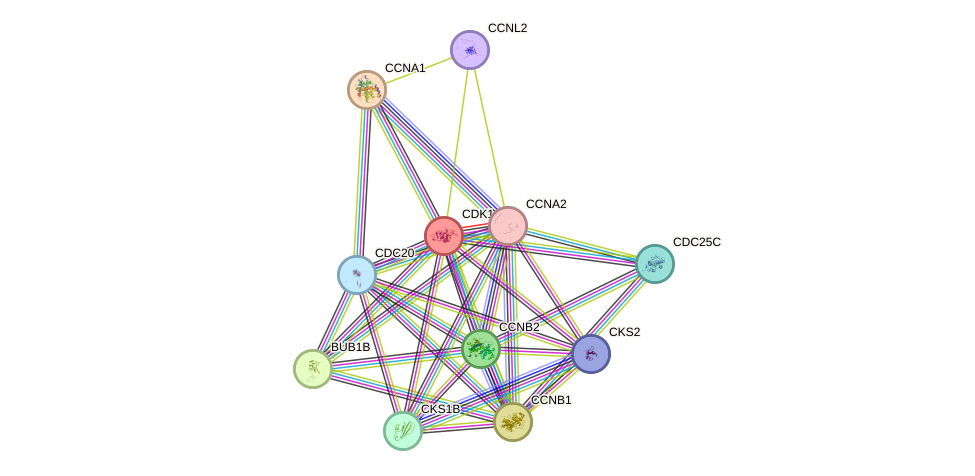GenAge entry for CDK1 (Homo sapiens)
Gene name (HAGRID: 201)
- HGNC symbol
- CDK1
- Aliases
- CDC28A; CDC2
- Common name
- cyclin-dependent kinase 1
Potential relevance to the human ageing process
- Main reason for selection
- Entry selected based on evidence showing that the gene product to be a target of genes previously linked to ageing
- Description
An important regulator of the cell cycle, CDK1 also appears to be involved in apoptosis. Age-related alterations to CDK1 have been reported in rats [875], but there is no direct evidence linking CDK1 to human ageing.
Cytogenetic information
- Cytogenetic band
- 10q21.1
- Location
- 60,778,454 bp to 60,794,852 bp
- Orientation
- Plus strand
Protein information
- Gene Ontology
-
Process: GO:0000082; G1/S transition of mitotic cell cycle
GO:0000083; regulation of transcription involved in G1/S transition of mitotic cell cycle
GO:0000086; G2/M transition of mitotic cell cycle
GO:0000187; activation of MAPK activity
GO:0000226; microtubule cytoskeleton organization
GO:0006260; DNA replication
GO:0006281; DNA repair
GO:0006461; protein complex assembly
GO:0006915; apoptotic process
GO:0006977; DNA damage response, signal transduction by p53 class mediator resulting in cell cycle arrest
GO:0007067; mitotic nuclear division
GO:0007077; mitotic nuclear envelope disassembly
GO:0007095; mitotic G2 DNA damage checkpoint
GO:0007098; centrosome cycle
GO:0007344; pronuclear fusion
GO:0007569; cell aging
GO:0008283; cell proliferation
GO:0009636; response to toxic substance
GO:0010628; positive regulation of gene expression
GO:0014038; regulation of Schwann cell differentiation
GO:0014070; response to organic cyclic compound
GO:0014075; response to amine
GO:0014823; response to activity
GO:0016477; cell migration
GO:0016572; histone phosphorylation
GO:0018105; peptidyl-serine phosphorylation
GO:0018107; peptidyl-threonine phosphorylation
GO:0030261; chromosome condensation
GO:0030855; epithelial cell differentiation
GO:0031100; animal organ regeneration
GO:0031145; anaphase-promoting complex-dependent catabolic process
GO:0033160; positive regulation of protein import into nucleus, translocation
GO:0034501; protein localization to kinetochore
GO:0042493; response to drug
GO:0042787; protein ubiquitination involved in ubiquitin-dependent protein catabolic process
GO:0043066; negative regulation of apoptotic process
GO:0043161; proteasome-mediated ubiquitin-dependent protein catabolic process
GO:0045471; response to ethanol
GO:0045740; positive regulation of DNA replication
GO:0045931; positive regulation of mitotic cell cycle
GO:0045995; regulation of embryonic development
GO:0046686; response to cadmium ion
GO:0046688; response to copper ion
GO:0048678; response to axon injury
GO:0051301; cell division
GO:0051436; negative regulation of ubiquitin-protein ligase activity involved in mitotic cell cycle
GO:0051437; positive regulation of ubiquitin-protein ligase activity involved in regulation of mitotic cell cycle transition
GO:0051439; regulation of ubiquitin-protein ligase activity involved in mitotic cell cycle
GO:0055015; ventricular cardiac muscle cell development
GO:0060045; positive regulation of cardiac muscle cell proliferation
GO:0070301; cellular response to hydrogen peroxide
GO:0090166; Golgi disassembly
GO:1900182; positive regulation of protein localization to nucleus
Cellular component: GO:0000784; nuclear chromosome, telomeric region
GO:0005634; nucleus
GO:0005654; nucleoplasm
GO:0005737; cytoplasm
GO:0005739; mitochondrion
GO:0005813; centrosome
GO:0005829; cytosol
GO:0005876; spindle microtubule
GO:0016020; membrane
GO:0030496; midbody
GO:0070062; extracellular exosome
GO:0072686; mitotic spindle
Hide GO termsFunction: GO:0003682; chromatin binding
GO:0004672; protein kinase activity
GO:0004674; protein serine/threonine kinase activity
GO:0004693; cyclin-dependent protein serine/threonine kinase activity
GO:0005515; protein binding
GO:0005524; ATP binding
GO:0008353; RNA polymerase II carboxy-terminal domain kinase activity
GO:0030332; cyclin binding
GO:0030544; Hsp70 protein binding
GO:0035173; histone kinase activity
Protein interactions and network
- Protein-protein interacting partners in GenAge
- TP53, E2F1, EGFR, BRCA1, RPA1, BCL2, VCP, HSP90AA1, ABL1, UBE2I, EP300, PML, FEN1, RB1, FOXM1, UCHL1, SIRT1, SP1, HMGB1, CCNA2, LMNB1, CDK1, TFDP1, POLA1, PPP1CA, TP53BP1, CDKN1A, HTRA2, SQSTM1, CDK7
- STRING interaction network
Retrieve sequences for CDK1
Homologs in model organisms
- Caenorhabditis elegans
- cdk-1
- Danio rerio
- cdk1
- Drosophila melanogaster
- cdc2
- Mus musculus
- Cdk1
- Rattus norvegicus
- Cdk1
- Saccharomyces cerevisiae
- CDC28

